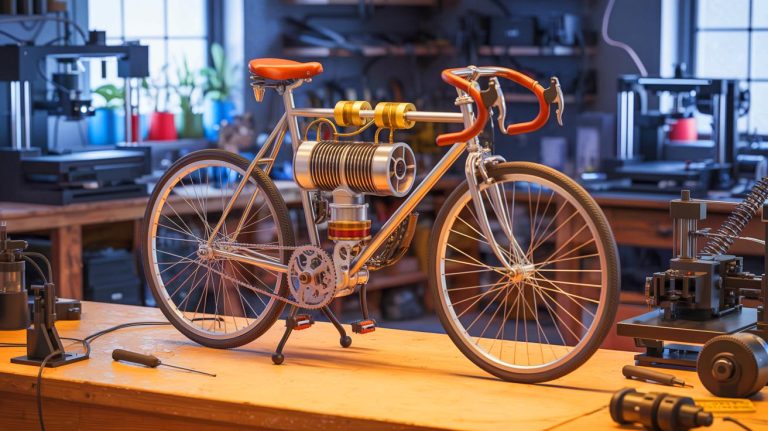| IN A NUTSHELL |
|
In an era where sustainable energy solutions are more crucial than ever, Tom Stanton, an innovative YouTuber and aerospace engineer, has captured the imagination of many by creating a bicycle powered by a Stirling engine. This engine, a relic of the early 19th century, operates solely on heat, showcasing the potential of combining historical technology with cutting-edge tools. Stanton’s project is a remarkable blend of past and present, demonstrating how age-old principles can be revitalized to challenge modern engineering norms. His work invites both curiosity and admiration from the engineering community and beyond.
The Stirling Engine: An Old Idea Reimagined
The Stirling engine, first patented in 1816, operates on a simple yet ingenious principle: it uses the expansion and contraction of air between a hot and a cold side to generate motion. This cyclical process allows for energy generation without traditional fuel sources. Tom Stanton embarked on a mission to leverage this principle to power a bicycle. His journey began with small-scale experiments, gradually evolving into a more sophisticated design involving a full aluminum engine block.
Stanton’s approach involved modern techniques such as 3D printing and CNC machining, which were instrumental in crafting the internal components and cranks. A key innovation was the use of a red-hot steel cap for heat input, complemented by water-cooling on the cold side to maintain efficiency. The breakthrough came with a flexible piston ring made from TPU, which minimized friction and sealed effectively. This combination of historical and modern techniques allowed Stanton to bring the Stirling engine to life in a new context.
Challenges in Building the Heat-Powered Bike
Building a functional bike powered by a Stirling engine was no small feat. These engines are notoriously difficult to optimize, especially for applications they were not originally designed for. Friction and air leaks posed significant challenges, threatening to undermine performance. Even the crank throw had to be precisely calibrated to ensure the engine’s effective operation.
The pivotal moment came with the creation of a 3D-printed flexible piston ring that effectively sealed the cylinder, allowing the engine to build the necessary pressure. This innovation was crucial in enabling the bike to produce between 100 to 150 watts of power, allowing speeds of up to 15 mph on flat terrain. Impressively, the engine could continue running on residual heat even after the primary heat source was removed, showcasing its efficiency.
Limitations and Innovations
While Stanton’s bike is not yet practical for everyday use, it illustrates the potential of combining old technology with modern tools. Stirling engines are typically not used for transportation due to their low power output and slow start-up times. However, Stanton’s use of CNC machines, 3D printers, and commercially available components has breathed new life into this historical concept.
Stanton continues to refine his design, considering enhancements such as thinner belts, a proper clutch, and a radiator loop for better temperature management. He is also exploring the addition of a regenerator to recycle heat, which could significantly improve efficiency. Despite its current limitations, the bike operates quietly and efficiently, powered solely by heat and air, challenging conventional ideas about engine design and energy use.
The Broader Implications of Heat-Driven Technology
Stanton’s creation is more than a technical novelty; it represents a broader exploration into sustainable energy solutions. By reviving the Stirling engine, Stanton underscores the untapped potential of historical technologies in addressing contemporary challenges. His work prompts reflection on how other long-established ideas might be adapted for modern energy and environmental concerns.
This project highlights the importance of innovation and creativity in the pursuit of sustainability. It serves as a reminder that solutions to today’s problems may lie in the past, waiting to be rediscovered and adapted. Stanton’s work challenges us to rethink our approach to energy and transportation, encouraging exploration beyond traditional methods.
Tom Stanton’s heat-powered bicycle is a testament to the enduring potential of historical technologies in solving modern problems. As the world continues to seek sustainable energy solutions, what other forgotten innovations wait to be rediscovered and reimagined for today’s challenges?
Did you like it? 4.4/5 (30)







This is amazing! I never thought a Stirling engine could power a bike. 🚴♂️🔥
How efficient is the bike in terms of energy consumption compared to traditional bikes?
Can’t wait to see this in action at my local bike shop. 🤔
Why not just use a regular electric bike? Seems overly complicated.
Thank you, Tom Stanton, for pushing the boundaries of what’s possible! 👏
Is this bike practical for everyday commutes, or is it more of a prototype?
Imagine if this technology was applied to cars! 🚗🔥
I love the blend of old and new technology. It’s like steampunk come to life!
How long does the bike take to start moving once the heat source is applied?
I’m skeptical about the long-term durability of the Stirling engine in this application. 🤨
What kind of heat source can be used for this bike?